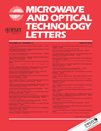Novel topology of compact coplanar waveguide resonant cell low-pass filter
Abstract
In this study, a novel pseudoelliptic function low-pass filter (LPF) constituted by a compact coplanar waveguide resonant cell has been designed and manufactured. The lumped-element seven-pole prototype has been adequately realized by using complementary perturbations located both in signal line and ground plane metallization. The fabricated uniplanar LPF offers a compact size of 5.6 × 9.8 mm2, return loss better than −26 dB over the passband, stop-band rejection better than 27 dB up to 8 GHz and a narrow transition band. The experimental results are in agreement with theoretical characteristics. The solution proposed is superior to the classic semilumped element counterpart in the level of length reduction (67% of abbreviation). © 2012 Wiley Periodicals, Inc. Microwave Opt Technol Lett 54:732–735, 2012; View this article online at wileyonlinelibrary.com. DOI 10.1002/mop.26594




